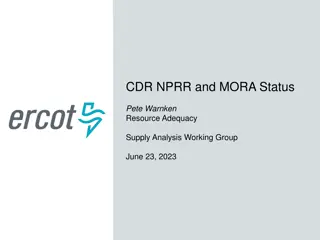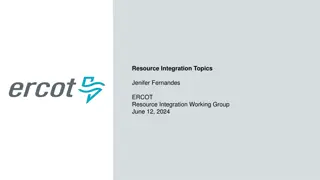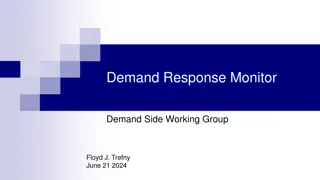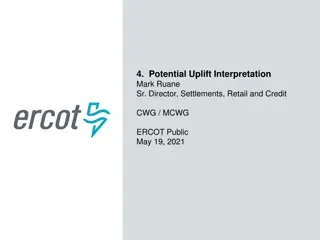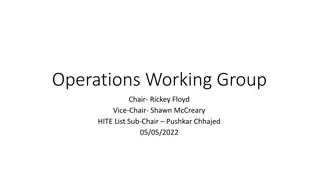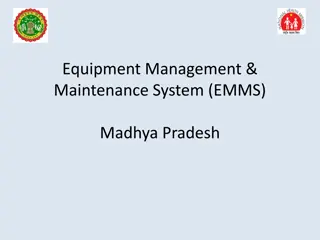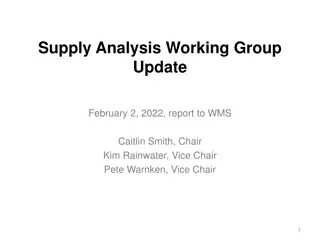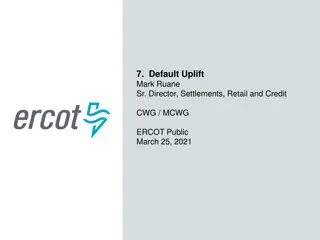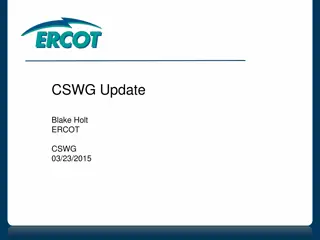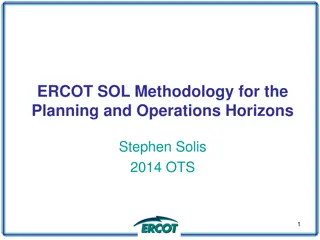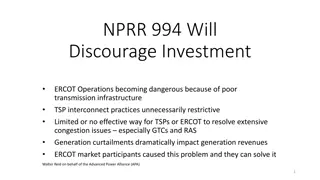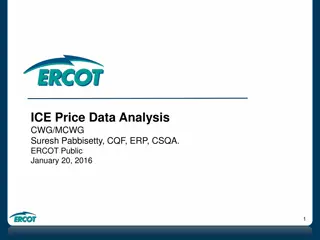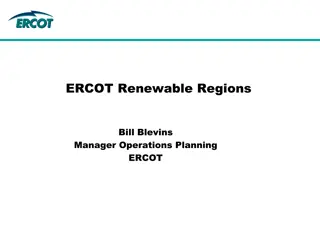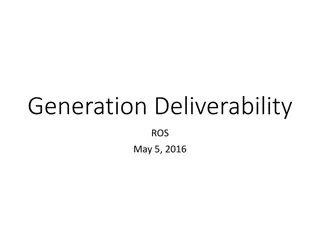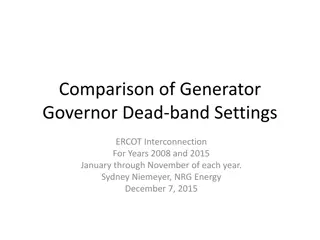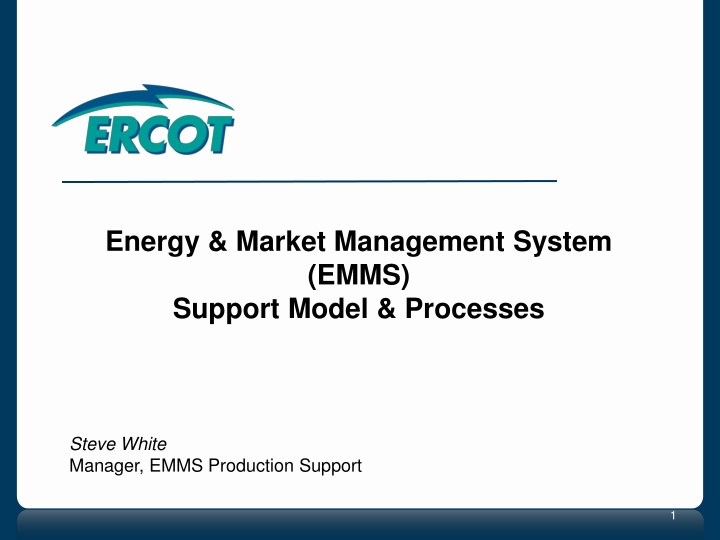
EMMS Support Model and Control Room Operations Overview
"Explore the Energy Market Management System (EMMS) Support Model, Control Room Operations Support, Telemetry Data Flow, Network Model Updates, Site Failover Process, and Monitoring for efficient Grid Reliability and ERCOT Market Impact."
Download Presentation

Please find below an Image/Link to download the presentation.
The content on the website is provided AS IS for your information and personal use only. It may not be sold, licensed, or shared on other websites without obtaining consent from the author. If you encounter any issues during the download, it is possible that the publisher has removed the file from their server.
You are allowed to download the files provided on this website for personal or commercial use, subject to the condition that they are used lawfully. All files are the property of their respective owners.
The content on the website is provided AS IS for your information and personal use only. It may not be sold, licensed, or shared on other websites without obtaining consent from the author.
E N D
Presentation Transcript
Energy & Market Management System (EMMS) Support Model & Processes Steve White Manager, EMMS Production Support 1
Objectives Upon completing this course of instruction, you will Recognize the EMMS Support Model and Control Room Operations Support. Understand QSE/TSP Telemetry Data Flow to EMMS Applications and EMMS Applications Data Flow to QSE. Recognize Telemetry issues impact on EMMS Applications. Identify the EMMS Network Model Update Process and look at TSP/QSE Model Load delay impacts on Grid Reliability. Understand the EMMS Site Failover Process and Impacts to Grid Reliability/ERCOT Market. 2
EMMS Support Model & EMMS Monitoring 3
Defined Roles Application changes - Requirements/Design Review Perform Detailed Applications Testing Applications Production/Control Room Support Application Engineers EMMS Production Support Review/Support Infrastructure Software builds Systems Support Systems Monitoring Control Room Support Systems Analyst Infrastructure Current/Future Systems Databases Applications Systems Monitoring Application Architect 4
EMMS Support Model What we do to support Control Room Operations? 24 X 7 Control Room Support on EMS and MMS Applications Weekly Network Model Load (DBLOAD) /DPC Implementation Site Failover / Disaster Recovery EMMS Support Model For Control Room Operations Operator Training Simulator and Macomber Map Support Control Room EMMS workstations Support QSE Resources AS Qualification Testing Support to Control Room 6
EMMS Support Model How is EMMS Production Group alerted to EMS & MMS Application Issues/Incidents related to Control Room? Control Room Operators Contacts EMMS Prod On-Call EMMS Monitoring EMMS Monitoring Enables EMMS Production to provide faster resolution to Production issues. EMMS Production alerted to possible production issues and resolves them before Control Room Operators experience the issue. Goal is to identify an Issue before it becomes an Incident. 7
EMMS Monitoring Server Unreachable Memory/CPU Disk Space Back-up Status Monitoring Database Memory/CPU Table Locks Long Execution Queries Archive Logs Replication Lags Application Execution Delay Log Errors Data Flow Delay Input Data Quality Results Validation 8
EMMS Monitoring - EMS System Site Overview Help desk contacts EMMS Production On-Call if any one of the component turns Red 9
EMMS Monitoring - ICCP Communication Status Control Room Operator or Help desk contacts EMMS Production On-Call if any one of the TSP/QSE links are down. 10
QSE/TSP Telemetry Data Flow to EMMS Applications & EMMS Applications Data Flow to QSE 11
EMS Applications Used by Control Room Operators Inter-Control Center Communication Control Protocol (ICCP): Application used to send and receive Telemetry data to Market Participants from and to EMS System. Supervisory Control and Data Acquisition (SCADA): Scans the telemetry Analog and Status points from ICCP every 2 seconds Performs the data quality and reasonability checks. Provides telemetry data to EMS Applications. Load Frequency Control (LFC): Executes every 4 seconds, Controls Grid Frequency Control Deploys Regulation, Responsive Reserves Performs Ancillary Service Capacity Monitor Calculations (Physical Responsive Reserve, RRS Capacity etc.) every 10 seconds. Resource Limit Calculator (RLC): Executes every 4 seconds Calculates Generation To Be Dispatched (GTBD) based on Generating Units Telemetered Current Generation, next 5 minute Load change and Regulation deployed value. Calculates Resource High/Low Ancillary Service Limits (HASL/LASL), High/Low Dispatch Limits (HDL/LDL), SCED Up/Down Ramp Rates based on the Telemetered High/Low Sustainable Limits (HSL/LSL), Telemetered Ancillary Service Responsibilities and Schedules. Limits are used in Real-Time Security Constraint Economic Dispatch (SCED) Application. 12
EMS Applications Used by Control Room Operators State Estimator (RTNET): Executes every 5 minutes determines the real-time network electrical state based on real-time network model, Telemetered SCADA Analog, Status Points data, operator entries. Detects errors in measurements and models, to the extent possible, maintains statistics, this information is available for system operators and network analysis applications (real-time contingency analysis, dynamic studies, study network analysis etc.). Real-time Contingency Analysis (RTCA): Executes every 5 minutes following the State Estimator completion. Performs power flow analysis on the real-time network model for base case as well as defined N-1 Contingencies and detects the voltage violation, MVA overloads. RTCA presents the base case/contingency violations information to Control Room Operators. RTCA also calculates the Units and Loads shift factors for each violation during each run. Transmission Constraint Manager (TCM): TCM Application provides a user interface to the Control Room and displays Transmission Lines/Transfers/ZBR/Interfaces real-time base case/Contingency violations (constraints) and corresponding violations shift factors. Control Room Operators activate the constraints to Real-Time Security Constraint Economic Dispatch (SCED) Application to resolve violations based on the overload percentage and constraints shift factors data. TCM application executes after RTCA has completed with a Valid Solution and captures all the required violations data and corresponding violation shift factors from RTCA. 13
EMS Applications Used by Control Room Operators Load Forecast (LF): LF performs Short Term Load Forecast (STLF), Mid Term Load Forecast (MTLF). STLF executes every 5 minutes and provides next 12 5-minute intervals load forecast, it is used in the Market System Look-Ahead Security Constraint Economic SCED (LA-SCED) application. MTLF runs every top of the hour and provides the future 7 days hourly forecast, It is used in Market System Hourly Reliability/Daily/Weekly Unit Commitment (HRUC/DRUC/WRUC) applications. Dynamic Ratings Application (DYNRTG): It runs every 5 minutes and calculates the Dynamically rated Lines ratings in real-time based on the Telemetered MVA, AMPS,TEMPERATURE and Weather Forecast and updates in SCADA for Real-Time Network Applications use (RTNET/RTCA). DYNRTG also calculates the next 7 seven days the Dynamically Rated Line ratings based on the next 7 days weather forecast. Forced Outage Detection (FOD): FOD Application executes every 10 seconds and reads the real-time topology changes to determine the documented and undocumented outages. Control Room Operators monitor the unit/load trips using the FOD application displays. 14
Market Management System (MMS) Applications Used by Control Room Operators Security Constraint Economic Dispatch (SCED): Executes every 5 minutes. SCED dispatches Generation Resources economically and maintains the system-wide power balance and reliability. SCED also determines ORDC reserves and ORDC Price Adders. During Real-Time operations, SCED dispatches Resources to match the system total generation requirement provided by the EMS while observing Resource and Transmission Constraints. SCED produces the Base Point & LMP for Resources, these data sets are transferred to Market Participants through ICCP. Reliability Unit Commitment (RUC): Reliability Unit Commitment (RUC) determines the commitment of the Generation Resources to match the forecasted system demand, and is subject to Transmission and Resource constraints. RUC commits additional Generation capacity on top of Resources already committed in previous RUCs, Resources that are self-committed in the Current Operating Plans (COPs), and Resource capacity already committed to provide Ancillary Service. ERCOT performs three RUC Process: Hourly RUC (HRUC) Day-Ahead RUC (DRUC) Weekly RUC (WRUC) - It is used for Study Purpose. 15
Market Management System (MMS) Applications Used by Control Room Operators AS Manager: Control Room Operators uses AS Manager application to deploy Non-Spin to Generating Units and Load Resources , Responsive Reserve to Non-Controllable Load Resources as well as Emergency Responsive Service (ERS) to ERS Loads. Non-Spin and Responsive Reserve deployments are transferred to Market Participants via XML deployment messages. EMS LFC Applications retrieves the Non-Spin and RRS deployments Flag from AS Manager for Ancillary Service monitoring. Non-spin Deployment flag is sent to QSE s through ICCP telemetry and QSE s update the Generating units Telemetered Non-Spin Schedule values. RRS Deployment flag is sent to QSE s through ICCP telemetry and QSE s update the Load Resources Telemetered RRS Schedule values. Supplemental Ancillary Service Market (SASM): Control Room Operator executes a SASM during the Adjustment Period to procure additional Regulation Down, Regulation Up, Responsive Reserve, and Non-Spin capacities as required. Control Room Operator will use SASM to procure Ancillary Services in the Adjustment Period to maintain AS capacity sufficiency for: Replacement of Ancillary Services capacity that is undeliverable due to transmission constraints. Replacement of Ancillary Services capacity due to failure to provide. 16
QSE/TSP Telemetry Data Flow to EMS & MMS Applications Load EMS Applications MMS Applications Forecasting Application Security Constrained Economic Dispatch (SCED) Resource Limit Calculator QSE/TSP ICCP (Telemetry) Ancillary Service (AS) Manager Load Frequency Control ICCP SCADA Reliability Unit Commitment (WRUC, DRUC, HRUC) State Estimator EMS->MMS Interface Real-Time Contingency Analysis Supplemental Ancillary Services Market (SASM) Transmission Constraint Manager (TCM) Look Ahead SCED (LASCED) Dynamic Ratings Day Ahead Market (DAM) Forced Outage Detection 18
QSE/TSP Telemetry Data Flow to MMS Applications QSE/TSP Telemetry Data to MMS Applications: EMS Applications validates the QSE/TSP Telemetry Data and transfer to MMS Applications. EMS Applications performs the calculations based on QSE/TSP Telemetry Data and transfer the calculated data to MMS Applications. SCED & Look-Ahead SCED: Receives Generating Units and Controllable Load Resources following telemetered data sets from EMS. Current Generating /Consuming MW Resource Status High Sustained Limit (HSL) Low Sustained Limit (LSL) Ancillary Service Responsibilities/Schedules Receives HDL/LDL, HASL/LASL data from the EMS Resource Limit Calculator Application. Receives transmission constraints and shift factors data set from the EMS Transmission Constraint Manager Application. Ancillary Service (AS) Manager: Receives Generating Unit and Load Resource telemetered data (HSL/LSL, Ancillary Service Responsibilities/Schedules, Resource Status etc.) from Resource Limit Calculator Application. 19
QSE/TSP Telemetry Data Flow to MMS Applications Reliability Unit Commitment (RUC): Receives Load Forecast from EMS Load Forecasting Application EMS Load Forecast Application uses Generating Units and Tie Lines Telemetered MW in forecasting calculations. Receives Generating Units Online/Offline Hours from EMS Forced Outage Detection Application EMS Forced Outage Detection Application determines the Generating Units Online/Offline Hours based on the Generating Units Telemetered Resource Status and MW. HRUC receives First Hour Breaker Status from EMS. SASM/DAM: Receives Generating Units Online/Offline Hours from EMS Forced Outage Detection Application EMS Forced Outage Detection Application determines the Generating Units Online/Offline Hours based on the Generating Units Telemetered Resource Status and MW. 20
EMMS Applications Data Flow to QSE MMS Applications EMS Applications Security Constrained Economic Dispatch (SCED) SCED Base Points and LMPs Resource Limit Calculator (RLC) QSE ICCP (Telemetry) ICCP SCADA Load RRS and Non-Spin Deployment Flag Frequency Control (LFC) Regulation/RRS Deployments to QSE Ancillary Service (AS) Manager Non-Spin and RRS Deployment Instructions Reliability Unit Commitment (DRUC, HRUC) RUC Commitment Instructions QSE Market Interface (Web Service) ERCOT TIBCO Web Service Supplemental Ancillary Services Market (SASM) SASM AS Awards Instructions QSE Manual Down Load of ERCOT Instructions ERCOT Market User Interface (MMS UI) Electronic Dispatch Instructions (VDI) 21
QSE/TSP Telemetry Issues - Impact on EMMS Applications 22
QSE Telemetry Issues Impact on EMMS Applications QSE Generating Units/Load Resources Telemetry Points (Good Quality but Invalid Values) Regulation Up/Down Participation Factors Regulation Up/Down, RRS, Non-Spin Ancillary Service Responsibilities/Schedules Resource Status (RST) MW/NPF, HSL/LSL Impacts Impacts Impacts 1. Incorrect Resource Online and Offline Hours Calculations. 2. Invalid RUC Resource Commitments 3. Units and Load Resource may not be available for Non-Spin/RRS Deployments. 1. Incorrect RLC Dispatch Limits/GTBD Calculations 2. May lead to SCED Dispatch/Prices issues. 3. LFC Ancillary Service Monitoring provides incorrect Physical Responsive Capacity, RRS Capacity to Control Room. 4. LFC Regulation/Responsive Reserve Deployments may not be same as QSE Awarded AS Quantity. 5. Incorrect LFC Emergency Base Point Deployment. 6. Invalid Units Non-Spin and Load Resource Deployments. 6. Control Room may not be able to maintain Grid Frequency effectively. 1. LFC - Incorrect Resource Level Regulation Up/Down Deployed calculations. 2. Incorrect Resources expected Generation Deviations are presented to Control Room. 23
TSP Telemetry Issues Impact on EMMS Applications TSP Transmission Equipment's Telemetry Points (Good Quality but Invalid Values) Bus Voltage, Line/Transformer Flow, Transformer Taps, Load MW/MVAR,AVR Status Amps, Temperature, MVA Rating TIE Lines MW CB/DSC Status Impacts Impacts Impacts Impacts 1. Short Term Load Forecast (STLF) generates bad quality forecast 2. Impacts Mid Term Load Forecast (MTLF) Quality 3. Incorrect LFC Load Area Calculations. 4. Impacts State Estimator Solution Quality. 1. State Estimator/Real- Time Contingency Analysis may not solve or solution quality will be impacted. 2. Transmission violations Shift Factor values may be incorrect. 3. May lead to SCED congestion management Issues. 4. Can make HRUC Commitments wrong. 1. State Estimator/Real- Time Contingency Analysis may not solve or solution quality will be impacted. 2. Impacts Voltage and Stability Limit Calculations. 1. Real-time Dynamic Ratings may be inaccurate. 2. False Transmissions Lines Violations may show up in State Estimator/Real-Time Contingency Analysis 24
QSE/TSP Telemetry Issues Impact on EMMS Applications QSE/TSP Telemetry Issues impacts directly or indirectly all EMS and MMS Applications. Load Frequency Control (LFC) Resource Limit Calculator (RLC) State Estimator Real-Time Contingency Analysis Forced Outage Detection Dynamic Ratings Load Forecast Security Constraint Economic Dispatch (SCED) Ancillary Service Deployments Reliability Unit Commitment (HRUC/DRUC) SASM/DAM All EMS applications have validation checks for Suspect/Garbage Quality Telemetry. EMS Applications applies Reasonability Limits if Telemetry Quality is Good but Value is Invalid for Only certain Telemetry Points (Unit MW, HSL/LSL etc.). It is Highly Critical to maintain the Good Quality Telemetry all the time to maintain the Grid Reliability and avoid impact to Market. 25
Network Model Update Process (DBLOAD) 26
EMMS Model Load Process - DBLOAD Update EMS, MMS, Outage Scheduler(OS) and PI systems to allow applications to run using a model that is closest to what is out on the Grid. Network Model includes Network Topology, Resource/QSE, Resource to QSE Relationship changes etc. EMMS Production creates a Model changes report and the Control Room reviews the model changes. EMMS Production loads the Network Model into Production EMS/MMS/OS/PI systems at Mid Night on scheduled DBLOAD date. Network Model Load is performed every week (called Weekly DBLOAD). 27
EMMS Model Load Process QSE NOMCR PROCESS CIM/XML Model NETWORK MODELING SYSTEM TSP EMMS Production Model Load Process Model Testing Of ICCP/EMS/MMS/ OS/PI Applications in Model Verification Environment Model Load into Production ICCP/EMS/MMS/ OS/PI Systems, Applications Verification Model Load into ICCP/EMS/MMS/ OS/PI Systems in Model Verification Environment 28
QSE Model Load Delays - Impacts to ERCOT Grid Reliability When are QSE Model Loads expected to happen? At the same time as the ERCOT Model Load, specifically when Resource to QSE Relationship changes to the Model. At the same time or prior to the ERCOT Model Load when there are New Resource/QSE Additions in the Model. What happens if QSE Model Load does NOT execute at the same time as the ERCOT Model load if Model has Resource to QSE Relationship changes? New QSE will not receive the ERCOT SCED Dispatch Instructions/Regulation Deployments. Impacts Grid Frequency Control 29
QSE Model Load Delays - Impacts to ERCOT Grid Reliability What happens if QSE Model Load does not happen at the same time as ERCOT Model load if Model has new Resource(s)/QSE(s)? QSE will not receive the resource base point instructions from ERCOT, so resource will not follow ERCOT base point instructions. Resource may be subjected to Base Point Deviation charges. Impacts Grid Frequency Control What happens if QSE Model is Loaded at same time as ERCOT Model load but Telemetry is NOT established for the new Resource(s)? ERCOT Applications sees Garbage/Suspect Quality telemetry for all analog points (MW, HSL/LSL, Resource Status, Ancillary Service etc.) that may lead to improper SCED dispatch instructions to the resource(s). Resource may be subjected to Base Point Deviation charges. Impacts Grid Frequency Control Can also impact SCED Real-Time Price 30
TSP Model Load Delays - Impacts to ERCOT Grid Reliability When are TSP Model Loads expected to happen? At the same time or prior to ERCOT Model Load specifically when there are significant topology changes (Example: Station Reconfigurations, New Stations etc.) What happens if TSP Model is Loaded at same time as ERCOT Model load but Telemetry is NOT established for the new network changes? ERCOT Applications see Garbage/Suspect Quality telemetry. State Estimator/Real-Time Contingency may not solve. ERCOT control room will not have visibility into transmission overloads and may not be able to manage transmission congestion effectively. 31
EMMS Site Failover 32
ERCOTs Data Center Configuration Taylor Bastrop INTERNET Internet Firewall Internet Firewall NETWORK & TELECOM MP WAN Firewall MP WAN Firewall MP WAN CORE SWITCH CORE SWITCH DEV Firewall TEST Firewall PROD Firewall EMMS Firewall PROD Firewall EMMS Firewall PROD EMMS DEV TEST PROD EMMS SERVERS STORAGE TCC1 TCC3 BCC1 33
EMMS Site Failover EMMS Site Failover - Transition EMMS Core systems from one Data Center to another ERCOT perform EMMS Site Failovers To practice Disaster Recovery Planning To perform Patching and Maintenance work on passive site. EMMS Site Failovers Frequency: Planned Site Failovers Quarterly (Planned Site Failovers are NOT scheduled peak Summer Months) Unplanned Site Failovers - can occur at any time depending on System, Hardware or Data Center issues. EMS/MMS Systems/Applications down time during Site Failover Transition: EMS System/Applications - < 2 minutes MMS System/Applications - 6 to 8 minutes 34
Site Failover Impacts to Grid Reliability/ERCOT Market 1 - 2 SCED intervals may not execute during Site Failover Transition. Emergency Base Points will be activated if SCED does not run for 2 consecutive 5 minute intervals (i.e. when time difference between Last Successful SCED run and Current Time >= 605 Seconds) Control Room Operator may deploy Emergency Base Points to maintain Grid frequency. At this time Resources will follow the emergency base point instructions from ERCOT in place of the SCED Dispatch Instructions. Emergency Base Points will be deactivated once SCED application is running in New Active Site and Control Room operator verifies SCED solution. ERCOT may perform SCED price correction depending on Emergency Base Point Deployments if required. 35
EMMS Site Failover Emergency Base Points Time difference between Last Successful SCED run and Current Time >= 605 Seconds Emergency Base Points Flag will be activated automatically Grid Yes Frequency Deviation within Tolerance? Operator deactivates Emergency Base Points Flag when SCED Solution is available in New Active Site No Control Room Operator Deploys Emergency Base Points Resources follow Emergency Base Points Instructions from ERCOT 36
Questions? 37
Questions Exam Please turn your iClicker on and answer each of the following questions. 38
Questions 1. Which one of the following is EMMS Support area for Control Room Operations? a) 24x7 EMS & MMS Applications Support b) Network Model Load c) QSE AS Qualification Testing Support d) All of the above 39
Questions 2. Who will receive Resource SCED Base Points from ERCOT EMS ICCP System? a) All QSE s b) All TSP s c) QSE who owns the Resource d) None 40
Questions 3. Which one of the following EMMS Applications are impacted by Real Time Telemetry issues? a) LFC b) SCED c) State Estimator d) All of the above 41
Questions 4. How Often ERCOT performs Network Model Updates? a) Quarterly b) Monthly c) Weekly d) Annually 42
Questions 5. How many consecutive 5 minute SCED intervals failures activates Emergency Base Points flag automatically? a) 3 b) 2 c) 4 d) 1 43
Questions 6. When QSE/TSP Network Model Load is expected to happen? a) After ERCOT Model Load b) At same time as ERCOT Model Load c) At any time d) Never 44


